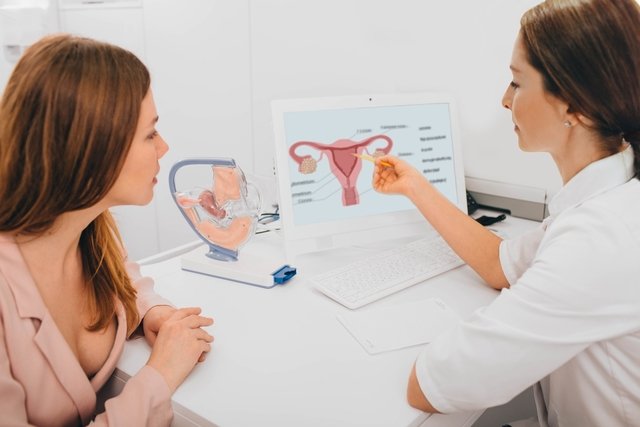Adenomyosis is the abnormal growth of cells in the layer lining the uterus, called the endometrium, within the muscular layer of the uterus, or myometrium, resulting in an enlarged uterus and symptoms such as a swollen belly, heavy or prolonged menstruation, or severe cramps during menstruation. .
The causes of adenomyosis are not fully known, but it is believed that it can arise due to gynecological surgeries or cesarean sections, which disrupt the deeper layers of the endometrium and myometrium, which can lead to the proliferation of endometrial cells within the myometrium.
The treatment of adenomyosis, also called uterine adenomyosis, is carried out by a gynecologist, who may recommend anti-inflammatory medications to alleviate symptoms, hormones, or surgery to remove the uterus.

Symptoms of adenomyosis
The main symptoms of adenomyosis are:
- Swelling in the belly;
- Feeling of pressure in the belly;
- Heavy menstrual bleeding;
- Prolonged menstruation;
- Very strong cramps during menstruation;
- Acute pelvic pain during menstruation;
- Chronic pelvic pain;
- Pain during intimate contact;
- Infertility.
Adenomyosis does not always cause symptoms, however, symptoms can generally appear 2 to 3 years after childbirth, even in cases where the woman has had adenomyosis since childhood, and generally disappear after menopause, when the menstrual cycle stops occurring. .
Furthermore, adenomyosis can be one of the causes of dysmenorrhea and abnormal uterine bleeding, and is often difficult to diagnose. Check out other signs of changes in the uterus.
Can adenomyosis affect pregnancy?
Adenomyosis can cause serious complications in pregnancy, such as ectopic pregnancy or miscarriage, for example, and regular monitoring by an obstetrician is recommended to avoid these complications.
Furthermore, in some cases, adenomyosis can make it difficult for the embryo to attach to the uterus, making pregnancy difficult. See other causes that can lead to changes in the size of the uterus and make pregnancy difficult.
How to confirm the diagnosis
The diagnosis of adenomyosis is made by the gynecologist, through the evaluation of symptoms such as pain, heavy bleeding or complaints of difficulty getting pregnant, health history and gynecological examination.
To confirm the diagnosis, the doctor must order imaging tests, such as transvaginal ultrasound or MRI, which are capable of showing the thickening of the uterus.
Make an appointment with your nearest gynecologist using the following tool to investigate the possibility of adenomyosis:
Taking care of your health has never been easier!
Possible causes
The causes of adenomyosis are not yet well understood, however, it is believed that trauma, inflammation, genetic and hormonal factors can lead to a proliferation of endometrial cells within the myometrium.
Some factors that may increase the risk of adenomyosis are:
- Age, being more common between 40 and 50 years old;
- More than one pregnancy in a lifetime;
- Cesarean delivery;
- Uterine curettage or dilation;
- Surgery to remove fibroids;
- Endometriosis;
- First menstruation before age 12;
- Short menstrual cycles;
- Overweight or obesity;
- Use of contraceptive pills;
- Use of tamoxifen.
Although the cause of adenomyosis is not fully known, it is known that exposure to the hormone estrogen can trigger adenomyosis.
Can adenomyosis turn into cancer?
Adenomyosis is a benign condition of the uterus, not related to cancer and also does not turn into cancer.
How the treatment is carried out
The treatment of adenomyosis varies according to the symptoms experienced and should be guided by a gynecologist.
The main treatments for adenomyosis are:
- Nonsteroidal anti-inflammatory drugssuch as ketoprofen or ibuprofen, to relieve pain and inflammation;
- Hormonal remediessuch as contraceptive pills with progesterone, danazol, contraceptive patch, vaginal ring or hormonal IUD;
- Surgery to remove excess endometrial tissue inside the uterusin cases where the adenomyosis is located in a specific region of the uterus and is not deeply penetrated into the muscle;
- Surgery to remove the uterus, called total hysterectomy, to completely remove the uterus. In this surgery, the ovaries generally do not need to be removed.
Surgery to remove the uterus completely eliminates the symptoms of the disease, but is only performed in more serious cases, when the woman no longer intends to become pregnant and when adenomyosis causes constant pain and profuse bleeding. Learn more about treatment options for adenomyosis.
Is adenomyosis the same as endometriosis?
Adenomyosis is considered a type of endometriosis, as it corresponds to the growth of endometrial tissue within the muscle of the uterus, and in some cases, a woman may have both adenomyosis and endometriosis at the same time. Understand what endometriosis is.
Furthermore, there are several types of adenomyosis, which can be focal adenomyosis, when it is located in a specific region of the uterus, or diffuse adenomyosis, when it spreads across the entire wall of the uterus, making it heavier and bulkier.
Watch the video with Dr. Helizabet Ribeiro, a gynecologist specializing in endometriosis who clarifies all doubts about this disease:

Sign up for our newsletter and stay up to date with exclusive news
that can transform your routine!
Warning: Undefined array key "title" in /home/storelat/public_html/wp-content/plugins/link-whisper-premium/templates/frontend/related-posts.php on line 12
Warning: Undefined array key "title_tag" in /home/storelat/public_html/wp-content/plugins/link-whisper-premium/templates/frontend/related-posts.php on line 13



